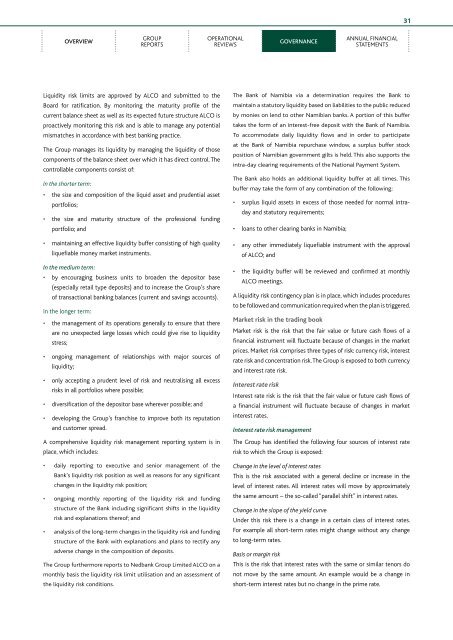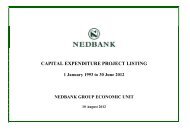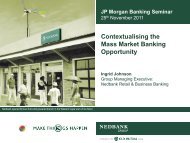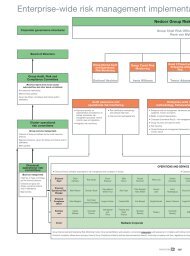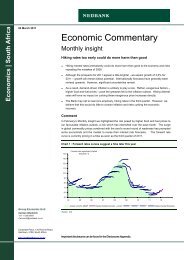annual financial statements - Nedbank Group Limited
annual financial statements - Nedbank Group Limited
annual financial statements - Nedbank Group Limited
Create successful ePaper yourself
Turn your PDF publications into a flip-book with our unique Google optimized e-Paper software.
oVeRView<br />
group<br />
reports<br />
liquidity risk limits are approved by Alco and submitted to the<br />
Board for ratification. By monitoring the maturity profile of the<br />
current balance sheet as well as its expected future structure Alco is<br />
proactively monitoring this risk and is able to manage any potential<br />
mismatches in accordance with best banking practice.<br />
the group manages its liquidity by managing the liquidity of those<br />
components of the balance sheet over which it has direct control. the<br />
controllable components consist of:<br />
In the shorter term:<br />
• the size and composition of the liquid asset and prudential asset<br />
portfolios;<br />
• the size and maturity structure of the professional funding<br />
portfolio; and<br />
• maintaining an effective liquidity buffer consisting of high quality<br />
liquefiable money market instruments.<br />
In the medium term:<br />
• by encouraging business units to broaden the depositor base<br />
(especially retail type deposits) and to increase the group’s share<br />
of transactional banking balances (current and savings accounts).<br />
in the longer term:<br />
• the management of its operations generally to ensure that there<br />
are no unexpected large losses which could give rise to liquidity<br />
stress;<br />
• ongoing management of relationships with major sources of<br />
liquidity;<br />
• only accepting a prudent level of risk and neutralising all excess<br />
risks in all portfolios where possible;<br />
• diversification of the depositor base wherever possible; and<br />
• developing the group’s franchise to improve both its reputation<br />
and customer spread.<br />
A comprehensive liquidity risk management reporting system is in<br />
place, which includes:<br />
• daily reporting to executive and senior management of the<br />
Bank’s liquidity risk position as well as reasons for any significant<br />
changes in the liquidity risk position;<br />
• ongoing monthly reporting of the liquidity risk and funding<br />
structure of the Bank including significant shifts in the liquidity<br />
risk and explanations thereof; and<br />
• analysis of the long-term changes in the liquidity risk and funding<br />
structure of the Bank with explanations and plans to rectify any<br />
adverse change in the composition of deposits.<br />
the group furthermore reports to nedbank group limited Alco on a<br />
monthly basis the liquidity risk limit utilisation and an assessment of<br />
the liquidity risk conditions.<br />
operAtionAl<br />
revieWs<br />
goVeRNaNCe<br />
AnnuAl finAnciAl<br />
stAtements<br />
31<br />
the Bank of namibia via a determination requires the Bank to<br />
maintain a statutory liquidity based on liabilities to the public reduced<br />
by monies on lend to other namibian banks. A portion of this buffer<br />
takes the form of an interest-free deposit with the Bank of namibia.<br />
to accommodate daily liquidity flows and in order to participate<br />
at the Bank of namibia repurchase window, a surplus buffer stock<br />
position of namibian government gilts is held. this also supports the<br />
intra-day clearing requirements of the national payment system.<br />
the Bank also holds an additional liquidity buffer at all times. this<br />
buffer may take the form of any combination of the following:<br />
• surplus liquid assets in excess of those needed for normal intraday<br />
and statutory requirements;<br />
• loans to other clearing banks in namibia;<br />
• any other immediately liquefiable instrument with the approval<br />
of Alco; and<br />
• the liquidity buffer will be reviewed and confirmed at monthly<br />
Alco meetings.<br />
A liquidity risk contingency plan is in place, which includes procedures<br />
to be followed and communication required when the plan is triggered.<br />
market risk in the trading book<br />
market risk is the risk that the fair value or future cash flows of a<br />
<strong>financial</strong> instrument will fluctuate because of changes in the market<br />
prices. market risk comprises three types of risk: currency risk, interest<br />
rate risk and concentration risk. the group is exposed to both currency<br />
and interest rate risk.<br />
Interest rate risk<br />
interest rate risk is the risk that the fair value or future cash flows of<br />
a <strong>financial</strong> instrument will fluctuate because of changes in market<br />
interest rates.<br />
Interest rate risk management<br />
the group has identified the following four sources of interest rate<br />
risk to which the group is exposed:<br />
Change in the level of interest rates<br />
this is the risk associated with a general decline or increase in the<br />
level of interest rates. All interest rates will move by approximately<br />
the same amount – the so-called “parallel shift” in interest rates.<br />
Change in the slope of the yield curve<br />
under this risk there is a change in a certain class of interest rates.<br />
for example all short-term rates might change without any change<br />
to long-term rates.<br />
Basis or margin risk<br />
this is the risk that interest rates with the same or similar tenors do<br />
not move by the same amount. An example would be a change in<br />
short-term interest rates but no change in the prime rate.


